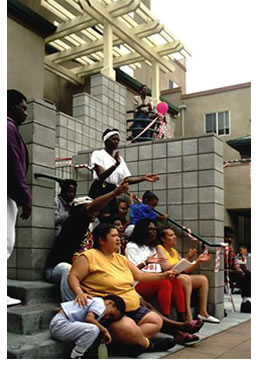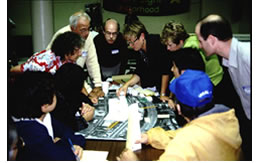|
Architectural education, a specialized combination of aesthetics and technical knowledge, is layered onto a complex set of beliefs which each of us carries into those chambers where that professional education first begins to impose itself upon us. Our pre-architecture beliefs and moral principles are nourished by a brief yet rich set of youthful life experiences that fuse whatever we learn from family, community, friends, teachers and religions. We carry some vague notion from those influences that, while we are expected to certainly pursue our own interests, somehow we are also expected to 'help others', 'pay back the debt we owe', direct our talents to 'improve society'. But almost immediately, that professional education assaults those core beliefs, tossing them into doubt and reconstructing them to suit other agendas.
For some, the immersion in architecture school seems to cause no trauma, other than exhaustion from all the hard work. Aesthetics as an abstract enterprise, devoid of social purpose, is presented as a higher moral pursuit, and should remain uncontaminated by noisy and distracting calls for environmental justice, economic and social equity, and service to all. It is a difficult challenge to the young mind, because teachers in higher education come with authority and the blessings of academic credibility. So many accept the notion of aesthetics as an abstract and self-referential pursuit as a higher state of morality.
But for some of us, contradictions between messages from our past and those promoted by elite design faculty slowly become clear. For myself, my personal roots spawned only a gradual awakening to these conflicts. Raised in the working class, Catholic tenements of Brooklyn, N.Y., the moral authority of the Church, State, parents and all teachers was embedded at an early age. At the same time, the basic notions of individual obligation to larger social purpose came both from the Church and the many families in the tenements whose parents were members of labor unions. The "preferential option for the poor" was a message promulgated by the Church at the time, and "solidarity forever" was the secular union message as protection against those with greater economic and political power. But the respect for authorities, regardless of their message, was deeply embedded.
So when esteemed architecture faculty and media presented design ideas in a social vacuum, supposedly possessing an internal logic of beauty devoid of social purpose, how could such authority be questioned? Yet, I had the good fortune of commuting to an architecture school merely a subway ride from my tenements. I could daily see the contrasts between the portrayal of architecture's history as the work of imperial heroes, and the daily struggles of the workers in the factory across the street from my tenement, where I worked through the night on my architecture projects.I could see the absurd juxtaposition of design studios focussed on escapist exercises, while nightly I saw the factories in my neighborhood slowly close as companies moved to southern US or offshore to exploit Third World labor. Surely there must be some way to direct the skills and talents of the design professions to these realities of my life?
My professional education took place during the Civil Rights struggle and the anti-Vietnam war protests of the 60's. I had millions of companions in my generation across the world simultaneously questioning their states, parents and all authorities for promoting ideas that seemed at their core to be unjust. That intra-generational support provided the nutrients to allow my past values and emerging professional skills to gel into a belief system that would steer the rest of my career.
I came to understand that the opinions and experiences of people from the most humble of backgrounds had equal value to those of professionals when shaping cities, neighborhoods, buildings, parks and in general, the uses of our natural resources. Incorporating their visions through participatory design methods seemed only the natural and right thing to do. And after many years of such practice, even when they may not be present during the act of design, their voices reverberate forever inside my head. Without realizing it, I have become a carrier and an advocate of their hopes, aspirations and needs. This is not to deny the poetic power of form, space, texture, color, light and nature's bounty-the ingredients of beautiful places-but their designed compositions are lifeless unless shaped to meet the needs of those they serve.
And it must be made clear that those who own and build such places---and buy our services to design them-more often than not, are not the people for whom we should be designing. I have at times found myself at odds with clients who, because of their class position as owners and users of property for profit, were in conflict with the needs of people already living in a neighborhood, or even with the needs of the ultimate occupiers and users of their property. So early in my career I recognized that the easiest way to avoid such conflicts is to direct my services to those who need them the most, and who often find themselves the victims of those who exploit property for private profit. This is not to say that private profit and moral performance are not incompatible, but it does mean that architects must carefully choose those clients who understand their larger social obligations when pursuing private profit.
So the fundamental question I think all students of architecture should ask of themselves while learning their trade is: 'How should your life experiences before entering architecture school merge with the values presented by your school? How do you want your past and emergent values to shape your career to meet the needs not only of your country, but of all humanity?
Michael Pyatok, FAIA
Berkeley Prize Committee 2001
|

Hisman Court, Oakland, California

James Lee Court, Oakland, California

Bayshore Community Meeting, Oakland, California
|